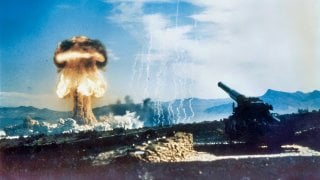Atomic Annie: The Army Built the World's Only Nuclear Artillery 'Cannon'
The M65 "Atomic Annie," introduced in 1952, was the world’s only nuclear artillery cannon. With an impressive range of 30 miles and armed with a 15-kiloton nuclear warhead, the 280mm gun was developed post-WWII as a Cold War deterrent.
What You Need to Know: The M65 "Atomic Annie," introduced in 1952, was the world’s only nuclear artillery cannon. With an impressive range of 30 miles and armed with a 15-kiloton nuclear warhead, the 280mm gun was developed post-WWII as a Cold War deterrent.
-Weighing 86 tons, it could be transported by two 4x4 trucks. Thankfully, it was fired only once, in a 1953 Nevada test, but saw deployment in Europe, Korea, and Okinawa. Seven units remain preserved in U.S. museums. Although never used in combat, Atomic Annie symbolized Cold War-era military advancements and strategic nuclear deterrence.
Atomic Annie Nuclear Cannon Profile
World War II buffs may remember the story of “Anzio Annie,” the Nazi German Wehrmacht’s Krupp K5 280 mm (eleven inch) railroad gun, that, along with its sister gun “Anzio Express,” made life a living hell for Allied troops during the eponymous Battle of Anzio that took place in the Italian towns/comunes of Anzio and Nettuno from January 22 to June 5, 1944. Which was coincidentally ending the day before the D-Day invasion. The Allies eventually did win the battle and liberated Rome as a result, but thanks to those aforementioned German big guns, that victory damn sure didn’t come easy.
Not to be outdone, during the heady days of the Cold War, the Americans would come up with an artillery piece that would one-up Anzio Annie in terms of sheer punching power, by virtue of a nuclear cannon! Say hello to the M65 280mm Motorized Heavy Gun, nicknamed “Atomic Annie,” and the world’s first and only nuclear gun.
M65 “Atomic Annie” Early History and Specifications
This fearsome gun was built by the manufactured at Watervliet and Watertown Arsenals in Watervliet, New York, and Watertown, Massachusetts respectively, and was officially introduced in 1952. According to Army Sustainment Command’s fact sheets, “The need for the M65 was defined in doctrine following the end of World War II. Specifically, it grew from the planned Allied Invasion of Japan (DOWNFALL) in 1945.
Use of small tactical atomic devices were anticipated to be used alongside of standing forces. Following this, deployment of smaller nuclear devices was commonplace for two key reasons. First, it provided a means of deterrence against potential Soviet invasion. Second, it was a way to inflict significant damage to an enemy at a relatively cheap materiel and personnel cost.”
Atomic Annie came with the following dimensions and vital stats:
Weight: 173,000 lb. (86 tons; (86 tons with its two 4x4 transport trucks included)
Length: eighty-four feet
Width: 16.1 feet
Height: 12.1 feet
Range: Up to thirty miles
Speed: thirty mph (the aforementioned 4x4 trucks)
Muzzle Velocity: 2,500 feet per second
Payload: W9 15-kiloton T124 280mm nuclear warhead; the shell itself weighed 562 lb.
Crew: five to seven
Variants: three
A total of twenty of these beastly behemoth blasters were produced. Each individual weapons system cost $800,000 USD in 1950s dollars, roughly equivalent to $8.9 million today when adjusted for inflation.
Operational History
Thankfully, WWIII never actually broke out, at least not yet anyway, and therefore Atomic Annie was never fired in anger. According to colleague my Brent M. Eastwood, “[T]he Atomic Cannon was only fired once, thankfully, and never brought on a nuclear crisis with the Soviet Union over its deployment…By 1953, the Army was ready to test the Atomic Gun. This happened at the Nevada Test Site (Nevada Proving Ground) during the Grable Test of Operation Upshot-Knothole after moving two cannons by rail from Fort Sill, Oklahoma…[T]hey were sent to Europe and Korea but were never fired again.”
The OCONUS (Outside the Continental United States) that Brent is referring to took place from April 1955 to December 1962. The gun was also deployed to Okinawa.
Where Is She Now?
Seven of these monster guns survive today, on display at the following locations:
-The U.S. Army Field Artillery Museum, Fort Sill, Oklahoma; the original Atomic Annie that fired that lone live nuclear shot; restored in 2010
-The United States Army Ordnance Training Support Facility (formerly known as the United States Army Ordnance Training and Heritage Center and U.S. Army Ordnance Museum), Petersburg, Virginia
-The National Museum of Nuclear Science & History, Albuquerque (cue Bugs Bunny), New Mexico
-The Rock Island Arsenal, Memorial Field, Rock Island, Illinois
-Watervliet Arsenal Museum, Watervliet Arsenal, Watervliet, New York
-Yuma Proving Ground, Yuma, Arizona
There is a popular misconception that there’s an eighth such surviving gun, more specifically a 240 mm prototype, at the Virginia War Museum in Newport News, Virginia. However, upon further review, it turns out that specimen in question is actually a conventional 240 mm T1 Gun, one of only two produced as part of a separate design program which was ended up getting the ix-nay for the sake of the T131 280 mm Atomic Cannon program.
About the Author:
Christian D. Orr is a Senior Defense Editor for National Security Journal (NSJ). He is a former Air Force Security Forces officer, Federal law enforcement officer, and private military contractor (with assignments worked in Iraq, the United Arab Emirates, Kosovo, Japan, Germany, and the Pentagon). Chris holds a B.A. in International Relations from the University of Southern California (USC) and an M.A. in Intelligence Studies (concentration in Terrorism Studies) from American Military University (AMU). He has also been published in The Daily Torch , The Journal of Intelligence and Cyber Security, and Simple Flying. Last but not least, he is a Companion of the Order of the Naval Order of the United States (NOUS).
Image Credit: Creative Commons and/or Shutterstock.


